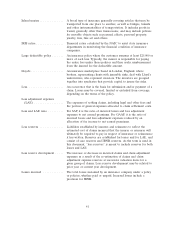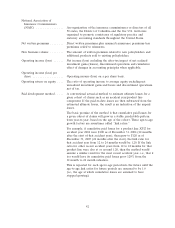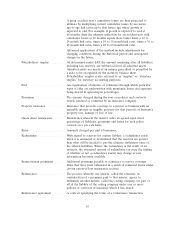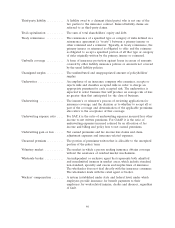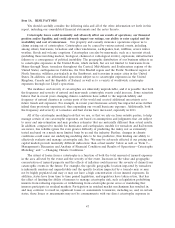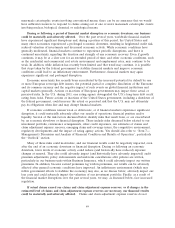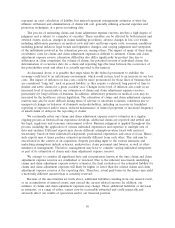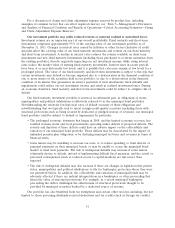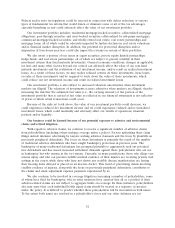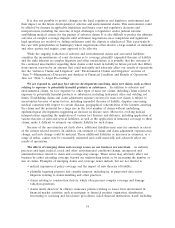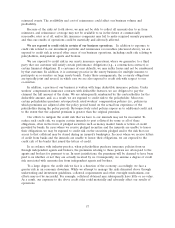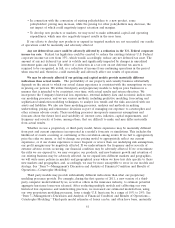Travelers 2011 Annual Report Download - page 63
Download and view the complete annual report
Please find page 63 of the 2011 Travelers annual report below. You can navigate through the pages in the report by either clicking on the pages listed below, or by using the keyword search tool below to find specific information within the annual report.For a discussion of claims and claim adjustment expense reserves by product line, including
examples of common factors that can affect required reserves, see ‘‘Item 7—Management’s Discussion
and Analysis of Financial Condition and Results of Operations—Critical Accounting Estimates—Claims
and Claim Adjustment Expense Reserves.’’
Our investment portfolio may suffer reduced returns or material realized or unrealized losses.
Investment returns are an important part of our overall profitability. Fixed maturity and short-term
investments comprised approximately 93% of the carrying value of our investment portfolio as of
December 31, 2011. Changes in interest rates caused by inflation or other factors (inclusive of credit
spreads) affect the carrying value of our fixed maturity investments and returns on our fixed maturity
and short-term investments. A decline in interest rates reduces the returns available on short-term
investments and new fixed maturity investments (including those purchased to re-invest maturities from
the existing portfolio), thereby negatively impacting our net investment income, while rising interest
rates reduce the market value of existing fixed maturity investments. Interest rates in recent periods
have been at or near historically low levels, and it is possible that rates may remain at low levels for a
prolonged period. The value of our fixed maturity and short-term investments is subject to the risk that
certain investments may default or become impaired due to a deterioration in the financial condition of
one or more issuers of the securities held in our portfolio, or due to a deterioration in the financial
condition of an insurer that guarantees an issuer’s payments of such investments. Such defaults and
impairments could reduce our net investment income and result in realized investment losses. During
an economic downturn, fixed maturity and short-term investments could be subject to a higher risk of
default.
Our fixed maturity investment portfolio is invested, in substantial part, in obligations of states,
municipalities and political subdivisions (collectively referred to as the municipal bond portfolio).
Notwithstanding the relatively low historical rates of default on many of these obligations and
notwithstanding that we typically seek to invest in high-credit-quality securities (including those with
structural protections such as being secured by dedicated or pledged sources of revenue), our municipal
bond portfolio could be subject to default or impairment. In particular:
• The prolonged economic downturn that began in 2008, and the limited economic recovery, has
resulted in many states and local governments operating under deficits or projected deficits. The
severity and duration of these deficits could have an adverse impact on the collectability and
valuation of our municipal bond portfolio. These deficits may be exacerbated by the impact of
unfunded pension plan obligations or by declining municipal tax bases and revenues in times of
financial stress.
• Some issuers may be unwilling to increase tax rates, or to reduce spending, to fund interest or
principal payments on their municipal bonds, or may be unable to access the municipal bond
market to fund such payments. The risk of widespread defaults may increase if some issuers
voluntarily choose to default, instead of implementing difficult fiscal measures, and the actual or
perceived consequences (such as reduced access to capital markets) are less severe than
expected.
• The risk of widespread defaults may also increase if there are changes in legislation that permit
states, municipalities and political subdivisions to file for bankruptcy protection where they were
not permitted before. In addition, the collectability and valuation of municipal bonds may be
adversely affected if there are judicial interpretations in a bankruptcy or other proceeding that
lessen the value of structural protections. For example, in a recent municipal bankruptcy
proceeding the debtor challenged the effectiveness of structural protections thought to be
provided by municipal securities backed by a dedicated source of revenue.
Our portfolio has also benefited from tax exemptions and certain other tax laws, including, but not
limited to, those governing dividends-received deductions and tax credits (such as foreign tax credits).
51


